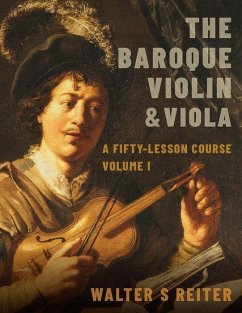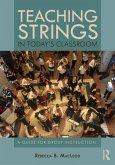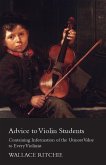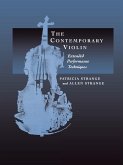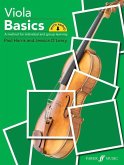Walter S. Reiter (Professor of Baroque Professor of Baroque Violin
The Baroque Violin & Viola
A Fifty-Lesson Course Volume I
Walter S. Reiter (Professor of Baroque Professor of Baroque Violin
The Baroque Violin & Viola
A Fifty-Lesson Course Volume I
- Broschiertes Buch
- Merkliste
- Auf die Merkliste
- Bewerten Bewerten
- Teilen
- Produkt teilen
- Produkterinnerung
- Produkterinnerung
A groundbreaking pedagogical work, The Baroque Violin & Viola, Volume I: A Fifty-Lesson Course blends Walter Reiter's experience as a renowned teacher and performer to guide the reader through the techniques and interpretive complexities of the Baroque violin repertory.
Andere Kunden interessierten sich auch für
![The Viola da Gamba The Viola da Gamba]() Bettina HoffmannThe Viola da Gamba51,99 €
Bettina HoffmannThe Viola da Gamba51,99 €![The Viola d'Amore The Viola d'Amore]() Rachael DurkinThe Viola d'Amore46,99 €
Rachael DurkinThe Viola d'Amore46,99 €![Teaching Strings in Today's Classroom Teaching Strings in Today's Classroom]() Rebecca MacLeod (US The University of North Carolina at GreensboroTeaching Strings in Today's Classroom61,99 €
Rebecca MacLeod (US The University of North Carolina at GreensboroTeaching Strings in Today's Classroom61,99 €![The Cello Suites: In Search of a Baroque Masterpiece The Cello Suites: In Search of a Baroque Masterpiece]() Eric SiblinThe Cello Suites: In Search of a Baroque Masterpiece17,99 €
Eric SiblinThe Cello Suites: In Search of a Baroque Masterpiece17,99 €![Advice to Violin Students - Containing Information of the Utmost Value to Every Violinist Advice to Violin Students - Containing Information of the Utmost Value to Every Violinist]() Wallace RitchieAdvice to Violin Students - Containing Information of the Utmost Value to Every Violinist27,99 €
Wallace RitchieAdvice to Violin Students - Containing Information of the Utmost Value to Every Violinist27,99 €![The Contemporary Violin The Contemporary Violin]() Patricia StrangeThe Contemporary Violin72,99 €
Patricia StrangeThe Contemporary Violin72,99 €![Viola Basics Viola Basics]() PAUL HARRISViola Basics19,99 €
PAUL HARRISViola Basics19,99 €-
-
-
A groundbreaking pedagogical work, The Baroque Violin & Viola, Volume I: A Fifty-Lesson Course blends Walter Reiter's experience as a renowned teacher and performer to guide the reader through the techniques and interpretive complexities of the Baroque violin repertory.
Hinweis: Dieser Artikel kann nur an eine deutsche Lieferadresse ausgeliefert werden.
Hinweis: Dieser Artikel kann nur an eine deutsche Lieferadresse ausgeliefert werden.
Produktdetails
- Produktdetails
- Verlag: Oxford University Press Inc
- Seitenzahl: 312
- Erscheinungstermin: 17. November 2020
- Englisch
- Abmessung: 275mm x 212mm x 19mm
- Gewicht: 794g
- ISBN-13: 9780190922702
- ISBN-10: 0190922702
- Artikelnr.: 59257328
- Herstellerkennzeichnung
- Libri GmbH
- Europaallee 1
- 36244 Bad Hersfeld
- gpsr@libri.de
- Verlag: Oxford University Press Inc
- Seitenzahl: 312
- Erscheinungstermin: 17. November 2020
- Englisch
- Abmessung: 275mm x 212mm x 19mm
- Gewicht: 794g
- ISBN-13: 9780190922702
- ISBN-10: 0190922702
- Artikelnr.: 59257328
- Herstellerkennzeichnung
- Libri GmbH
- Europaallee 1
- 36244 Bad Hersfeld
- gpsr@libri.de
Walter Reiter is internationally recognized as a leading Baroque violinist, leader and conductor. He has made countless recordings with both British and European Baroque orchestras as well as several highly acclaimed solo CDs. A devoted and experienced teacher of both modern and Baroque violin, he is currently Professor of Baroque Violin and Viola in the Royal Conservatoire of The Hague in the Netherlands.
* Foreword
* Introductory quotes
* Questions and Answers
* Part One
* The Basics
* Lesson One. Prelude
* Choosing a Violin - Choosing a Bow - Strings - Pitch.
* Lesson Two. Holding the violin
* How to hold the Baroque violin: a beginner's guide.
* Lesson Three. The Bow, Creator of Sound
* Holding the Bow.
* Lesson Four. First Sounds: Celebrating our Vocal Heritage
* Searching for our Vocal Roots - Exploring the Rhythm of words -
Postscript.
* Lesson Five. Copying the Human Voice: Sweelinck's Garrulous Little
Swallow
* Vowels - Dipthongs - Consonants - Double Consonants - Bowings -
Postscript.
* Lesson Six. Five Exercises to Help Accustom You to 'Chinless' Playing
* Recalling These Exercises in a Performance Situation - Technical
Factors - Emotional Factors - Nerves.
* Lesson Seven. More Basic Concepts and Techniques. 'A Division on a
Ground' by Mr Faronell, from 'The Division Violin,' London, 1684
* The Importance of the Bass Line - Tempo and Rhythm - The Hierarchies
and the Bow Impulses - Engramelle - Good Notes and Bad Notes -
Varying the Articulation.
* Lesson Eight. Learning to Feel. Developing a heightened awareness of
the Emotional Power of Sound and the Intervals
* Emotional Information: What Sound Tells Us - How to Prepare:
Manipulating Our Emotions.
* Lesson Nine. The Inner Life of Sound: 'Messa di voce'
* Lesson Ten. Applying the Messa di voce. Arcangelo Corelli: Adagio
from Sonata Opus V No 3
* Applying the 'Messa di voce' - Dissonances and Consonances - On
Trills - In Praise of the Second Position - Hemiolas: To be Heard as
Well as Seen? - A Note on Chromatic Fingering - Sound and Expression
- Summary
* Lesson Eleven: Temperament and 'Historical' Intonation: an Outline
* How Do We Learn 'Pure' Intonation? - Leopold Mozart on Overtones -
Peter Prelleur's Fingerboard.
* Lesson Twelve. Scale Exercises and Etudes for Shifting and Intonation
* Part One: Towards a Chinless Scale Book
* The Four Springs - Techniques of Displacement - Shifting and
Expression.
* Part Two: Fifteen Exercises for the Methodical Study of Pure
Intonation. Applying Pure Intonation to Geminiani's Scale Studies
from 'The Art of Playing the Violin (1751)
* Lesson Thirteen. Bringing Fast Notes to Life: the Inequality of the
Equal. Albinoni. Sonata Op V1 No 2, Allegro
* How to Play Equal Notes in a Flexible and Subtle Way - The Three
Flexibilities - Rhythmic flexibility - Dynamic flexibility -
Flexibility of articulation - Adding Slurs: a Misdemeanour? -
Sequences.
* Lesson Fourteen. Learning to Feel Comfortable on Gut Strings. I) The
Bow
* Lesson Fifteen. Learning to Feel Comfortable on Gut Strings. II) The
Left Hand
* Slaves of our Inner Voice: the Fingers.
* Part Two
* Re-examining the Familiar: Sonatas by Vivaldi and Corelli
* Lesson Sixteen. The Starting-point of Interpretation: Learning to
Observe
* Arcangelo Corelli: Sonata Op V no VII
* Interpretation: a Question of Taste? - Editions or Facsimiles? -
Instrumentation in Corelli's Opus V Sonatas - Means of Expression -
Choosing a Convincing Tempo - Preludio - Afterthought: What Happens
Within.
* Lesson Seventeen. Corelli. Sonata Op V No VII. Corrente - Sarabanda -
Giga
* Lesson Eighteen. Transforming musical decisions into sound
* Lesson Nineteen. In the Footsteps of Corelli. Antonio Vivaldi: Sonata
Op 2 No 1
* Preludio.
* Gesture - Shifting: How, When and Whither? - Open Strings: Use or
Misuse- Notes Essential and Notes Ornamental
* Lesson Twenty. In the Footsteps of Corelli. Antonio Vivaldi: Sonata
Op 2 No 1
* Giga, Sarabanda Largo, Corrente.
* Emotional Information in Rhythm - Learning to Read Vivaldi's Sonata
in the Original Notation
* Lesson Twenty-One. Nurturing Spontaneity: Ornamentation, Module One
* Ornamentation: Diversion or Essence? - Overcoming Our Fear of Playing
the Unwritten - Ornamentation and National Styles - Composed
Ornamentation - First Steps in Ornamenting: Corelli's Sarabanda -
Ornamenting the Second Half of the Sarabanda - Corelli's Sarabanda
Ornamented by Dubourg.
* Lesson Twenty-Two. Straight from the Heart: the Great Vibrato Debate
* Lesson Twenty-Three. Rhetoric: the Power to Persuade
* The Origins of Rhetoric - Rhetoric and Music - The Musician as Orator
- Rhetorical Playing Versus Pure Instrumentalism - Some Rhetorical
Figures: Dynamics, Parenthesis, Repetition, Direction, Punctuation
and Intonation - Tonality - Dissonance - Tessitura - Tempo - Metre -
Acoustic - Imagery - Presentation.
* Notes to Lessons
* Bibliography
* Index
* Acknowledgements
* Introductory quotes
* Questions and Answers
* Part One
* The Basics
* Lesson One. Prelude
* Choosing a Violin - Choosing a Bow - Strings - Pitch.
* Lesson Two. Holding the violin
* How to hold the Baroque violin: a beginner's guide.
* Lesson Three. The Bow, Creator of Sound
* Holding the Bow.
* Lesson Four. First Sounds: Celebrating our Vocal Heritage
* Searching for our Vocal Roots - Exploring the Rhythm of words -
Postscript.
* Lesson Five. Copying the Human Voice: Sweelinck's Garrulous Little
Swallow
* Vowels - Dipthongs - Consonants - Double Consonants - Bowings -
Postscript.
* Lesson Six. Five Exercises to Help Accustom You to 'Chinless' Playing
* Recalling These Exercises in a Performance Situation - Technical
Factors - Emotional Factors - Nerves.
* Lesson Seven. More Basic Concepts and Techniques. 'A Division on a
Ground' by Mr Faronell, from 'The Division Violin,' London, 1684
* The Importance of the Bass Line - Tempo and Rhythm - The Hierarchies
and the Bow Impulses - Engramelle - Good Notes and Bad Notes -
Varying the Articulation.
* Lesson Eight. Learning to Feel. Developing a heightened awareness of
the Emotional Power of Sound and the Intervals
* Emotional Information: What Sound Tells Us - How to Prepare:
Manipulating Our Emotions.
* Lesson Nine. The Inner Life of Sound: 'Messa di voce'
* Lesson Ten. Applying the Messa di voce. Arcangelo Corelli: Adagio
from Sonata Opus V No 3
* Applying the 'Messa di voce' - Dissonances and Consonances - On
Trills - In Praise of the Second Position - Hemiolas: To be Heard as
Well as Seen? - A Note on Chromatic Fingering - Sound and Expression
- Summary
* Lesson Eleven: Temperament and 'Historical' Intonation: an Outline
* How Do We Learn 'Pure' Intonation? - Leopold Mozart on Overtones -
Peter Prelleur's Fingerboard.
* Lesson Twelve. Scale Exercises and Etudes for Shifting and Intonation
* Part One: Towards a Chinless Scale Book
* The Four Springs - Techniques of Displacement - Shifting and
Expression.
* Part Two: Fifteen Exercises for the Methodical Study of Pure
Intonation. Applying Pure Intonation to Geminiani's Scale Studies
from 'The Art of Playing the Violin (1751)
* Lesson Thirteen. Bringing Fast Notes to Life: the Inequality of the
Equal. Albinoni. Sonata Op V1 No 2, Allegro
* How to Play Equal Notes in a Flexible and Subtle Way - The Three
Flexibilities - Rhythmic flexibility - Dynamic flexibility -
Flexibility of articulation - Adding Slurs: a Misdemeanour? -
Sequences.
* Lesson Fourteen. Learning to Feel Comfortable on Gut Strings. I) The
Bow
* Lesson Fifteen. Learning to Feel Comfortable on Gut Strings. II) The
Left Hand
* Slaves of our Inner Voice: the Fingers.
* Part Two
* Re-examining the Familiar: Sonatas by Vivaldi and Corelli
* Lesson Sixteen. The Starting-point of Interpretation: Learning to
Observe
* Arcangelo Corelli: Sonata Op V no VII
* Interpretation: a Question of Taste? - Editions or Facsimiles? -
Instrumentation in Corelli's Opus V Sonatas - Means of Expression -
Choosing a Convincing Tempo - Preludio - Afterthought: What Happens
Within.
* Lesson Seventeen. Corelli. Sonata Op V No VII. Corrente - Sarabanda -
Giga
* Lesson Eighteen. Transforming musical decisions into sound
* Lesson Nineteen. In the Footsteps of Corelli. Antonio Vivaldi: Sonata
Op 2 No 1
* Preludio.
* Gesture - Shifting: How, When and Whither? - Open Strings: Use or
Misuse- Notes Essential and Notes Ornamental
* Lesson Twenty. In the Footsteps of Corelli. Antonio Vivaldi: Sonata
Op 2 No 1
* Giga, Sarabanda Largo, Corrente.
* Emotional Information in Rhythm - Learning to Read Vivaldi's Sonata
in the Original Notation
* Lesson Twenty-One. Nurturing Spontaneity: Ornamentation, Module One
* Ornamentation: Diversion or Essence? - Overcoming Our Fear of Playing
the Unwritten - Ornamentation and National Styles - Composed
Ornamentation - First Steps in Ornamenting: Corelli's Sarabanda -
Ornamenting the Second Half of the Sarabanda - Corelli's Sarabanda
Ornamented by Dubourg.
* Lesson Twenty-Two. Straight from the Heart: the Great Vibrato Debate
* Lesson Twenty-Three. Rhetoric: the Power to Persuade
* The Origins of Rhetoric - Rhetoric and Music - The Musician as Orator
- Rhetorical Playing Versus Pure Instrumentalism - Some Rhetorical
Figures: Dynamics, Parenthesis, Repetition, Direction, Punctuation
and Intonation - Tonality - Dissonance - Tessitura - Tempo - Metre -
Acoustic - Imagery - Presentation.
* Notes to Lessons
* Bibliography
* Index
* Acknowledgements
* Foreword
* Introductory quotes
* Questions and Answers
* Part One
* The Basics
* Lesson One. Prelude
* Choosing a Violin - Choosing a Bow - Strings - Pitch.
* Lesson Two. Holding the violin
* How to hold the Baroque violin: a beginner's guide.
* Lesson Three. The Bow, Creator of Sound
* Holding the Bow.
* Lesson Four. First Sounds: Celebrating our Vocal Heritage
* Searching for our Vocal Roots - Exploring the Rhythm of words -
Postscript.
* Lesson Five. Copying the Human Voice: Sweelinck's Garrulous Little
Swallow
* Vowels - Dipthongs - Consonants - Double Consonants - Bowings -
Postscript.
* Lesson Six. Five Exercises to Help Accustom You to 'Chinless' Playing
* Recalling These Exercises in a Performance Situation - Technical
Factors - Emotional Factors - Nerves.
* Lesson Seven. More Basic Concepts and Techniques. 'A Division on a
Ground' by Mr Faronell, from 'The Division Violin,' London, 1684
* The Importance of the Bass Line - Tempo and Rhythm - The Hierarchies
and the Bow Impulses - Engramelle - Good Notes and Bad Notes -
Varying the Articulation.
* Lesson Eight. Learning to Feel. Developing a heightened awareness of
the Emotional Power of Sound and the Intervals
* Emotional Information: What Sound Tells Us - How to Prepare:
Manipulating Our Emotions.
* Lesson Nine. The Inner Life of Sound: 'Messa di voce'
* Lesson Ten. Applying the Messa di voce. Arcangelo Corelli: Adagio
from Sonata Opus V No 3
* Applying the 'Messa di voce' - Dissonances and Consonances - On
Trills - In Praise of the Second Position - Hemiolas: To be Heard as
Well as Seen? - A Note on Chromatic Fingering - Sound and Expression
- Summary
* Lesson Eleven: Temperament and 'Historical' Intonation: an Outline
* How Do We Learn 'Pure' Intonation? - Leopold Mozart on Overtones -
Peter Prelleur's Fingerboard.
* Lesson Twelve. Scale Exercises and Etudes for Shifting and Intonation
* Part One: Towards a Chinless Scale Book
* The Four Springs - Techniques of Displacement - Shifting and
Expression.
* Part Two: Fifteen Exercises for the Methodical Study of Pure
Intonation. Applying Pure Intonation to Geminiani's Scale Studies
from 'The Art of Playing the Violin (1751)
* Lesson Thirteen. Bringing Fast Notes to Life: the Inequality of the
Equal. Albinoni. Sonata Op V1 No 2, Allegro
* How to Play Equal Notes in a Flexible and Subtle Way - The Three
Flexibilities - Rhythmic flexibility - Dynamic flexibility -
Flexibility of articulation - Adding Slurs: a Misdemeanour? -
Sequences.
* Lesson Fourteen. Learning to Feel Comfortable on Gut Strings. I) The
Bow
* Lesson Fifteen. Learning to Feel Comfortable on Gut Strings. II) The
Left Hand
* Slaves of our Inner Voice: the Fingers.
* Part Two
* Re-examining the Familiar: Sonatas by Vivaldi and Corelli
* Lesson Sixteen. The Starting-point of Interpretation: Learning to
Observe
* Arcangelo Corelli: Sonata Op V no VII
* Interpretation: a Question of Taste? - Editions or Facsimiles? -
Instrumentation in Corelli's Opus V Sonatas - Means of Expression -
Choosing a Convincing Tempo - Preludio - Afterthought: What Happens
Within.
* Lesson Seventeen. Corelli. Sonata Op V No VII. Corrente - Sarabanda -
Giga
* Lesson Eighteen. Transforming musical decisions into sound
* Lesson Nineteen. In the Footsteps of Corelli. Antonio Vivaldi: Sonata
Op 2 No 1
* Preludio.
* Gesture - Shifting: How, When and Whither? - Open Strings: Use or
Misuse- Notes Essential and Notes Ornamental
* Lesson Twenty. In the Footsteps of Corelli. Antonio Vivaldi: Sonata
Op 2 No 1
* Giga, Sarabanda Largo, Corrente.
* Emotional Information in Rhythm - Learning to Read Vivaldi's Sonata
in the Original Notation
* Lesson Twenty-One. Nurturing Spontaneity: Ornamentation, Module One
* Ornamentation: Diversion or Essence? - Overcoming Our Fear of Playing
the Unwritten - Ornamentation and National Styles - Composed
Ornamentation - First Steps in Ornamenting: Corelli's Sarabanda -
Ornamenting the Second Half of the Sarabanda - Corelli's Sarabanda
Ornamented by Dubourg.
* Lesson Twenty-Two. Straight from the Heart: the Great Vibrato Debate
* Lesson Twenty-Three. Rhetoric: the Power to Persuade
* The Origins of Rhetoric - Rhetoric and Music - The Musician as Orator
- Rhetorical Playing Versus Pure Instrumentalism - Some Rhetorical
Figures: Dynamics, Parenthesis, Repetition, Direction, Punctuation
and Intonation - Tonality - Dissonance - Tessitura - Tempo - Metre -
Acoustic - Imagery - Presentation.
* Notes to Lessons
* Bibliography
* Index
* Acknowledgements
* Introductory quotes
* Questions and Answers
* Part One
* The Basics
* Lesson One. Prelude
* Choosing a Violin - Choosing a Bow - Strings - Pitch.
* Lesson Two. Holding the violin
* How to hold the Baroque violin: a beginner's guide.
* Lesson Three. The Bow, Creator of Sound
* Holding the Bow.
* Lesson Four. First Sounds: Celebrating our Vocal Heritage
* Searching for our Vocal Roots - Exploring the Rhythm of words -
Postscript.
* Lesson Five. Copying the Human Voice: Sweelinck's Garrulous Little
Swallow
* Vowels - Dipthongs - Consonants - Double Consonants - Bowings -
Postscript.
* Lesson Six. Five Exercises to Help Accustom You to 'Chinless' Playing
* Recalling These Exercises in a Performance Situation - Technical
Factors - Emotional Factors - Nerves.
* Lesson Seven. More Basic Concepts and Techniques. 'A Division on a
Ground' by Mr Faronell, from 'The Division Violin,' London, 1684
* The Importance of the Bass Line - Tempo and Rhythm - The Hierarchies
and the Bow Impulses - Engramelle - Good Notes and Bad Notes -
Varying the Articulation.
* Lesson Eight. Learning to Feel. Developing a heightened awareness of
the Emotional Power of Sound and the Intervals
* Emotional Information: What Sound Tells Us - How to Prepare:
Manipulating Our Emotions.
* Lesson Nine. The Inner Life of Sound: 'Messa di voce'
* Lesson Ten. Applying the Messa di voce. Arcangelo Corelli: Adagio
from Sonata Opus V No 3
* Applying the 'Messa di voce' - Dissonances and Consonances - On
Trills - In Praise of the Second Position - Hemiolas: To be Heard as
Well as Seen? - A Note on Chromatic Fingering - Sound and Expression
- Summary
* Lesson Eleven: Temperament and 'Historical' Intonation: an Outline
* How Do We Learn 'Pure' Intonation? - Leopold Mozart on Overtones -
Peter Prelleur's Fingerboard.
* Lesson Twelve. Scale Exercises and Etudes for Shifting and Intonation
* Part One: Towards a Chinless Scale Book
* The Four Springs - Techniques of Displacement - Shifting and
Expression.
* Part Two: Fifteen Exercises for the Methodical Study of Pure
Intonation. Applying Pure Intonation to Geminiani's Scale Studies
from 'The Art of Playing the Violin (1751)
* Lesson Thirteen. Bringing Fast Notes to Life: the Inequality of the
Equal. Albinoni. Sonata Op V1 No 2, Allegro
* How to Play Equal Notes in a Flexible and Subtle Way - The Three
Flexibilities - Rhythmic flexibility - Dynamic flexibility -
Flexibility of articulation - Adding Slurs: a Misdemeanour? -
Sequences.
* Lesson Fourteen. Learning to Feel Comfortable on Gut Strings. I) The
Bow
* Lesson Fifteen. Learning to Feel Comfortable on Gut Strings. II) The
Left Hand
* Slaves of our Inner Voice: the Fingers.
* Part Two
* Re-examining the Familiar: Sonatas by Vivaldi and Corelli
* Lesson Sixteen. The Starting-point of Interpretation: Learning to
Observe
* Arcangelo Corelli: Sonata Op V no VII
* Interpretation: a Question of Taste? - Editions or Facsimiles? -
Instrumentation in Corelli's Opus V Sonatas - Means of Expression -
Choosing a Convincing Tempo - Preludio - Afterthought: What Happens
Within.
* Lesson Seventeen. Corelli. Sonata Op V No VII. Corrente - Sarabanda -
Giga
* Lesson Eighteen. Transforming musical decisions into sound
* Lesson Nineteen. In the Footsteps of Corelli. Antonio Vivaldi: Sonata
Op 2 No 1
* Preludio.
* Gesture - Shifting: How, When and Whither? - Open Strings: Use or
Misuse- Notes Essential and Notes Ornamental
* Lesson Twenty. In the Footsteps of Corelli. Antonio Vivaldi: Sonata
Op 2 No 1
* Giga, Sarabanda Largo, Corrente.
* Emotional Information in Rhythm - Learning to Read Vivaldi's Sonata
in the Original Notation
* Lesson Twenty-One. Nurturing Spontaneity: Ornamentation, Module One
* Ornamentation: Diversion or Essence? - Overcoming Our Fear of Playing
the Unwritten - Ornamentation and National Styles - Composed
Ornamentation - First Steps in Ornamenting: Corelli's Sarabanda -
Ornamenting the Second Half of the Sarabanda - Corelli's Sarabanda
Ornamented by Dubourg.
* Lesson Twenty-Two. Straight from the Heart: the Great Vibrato Debate
* Lesson Twenty-Three. Rhetoric: the Power to Persuade
* The Origins of Rhetoric - Rhetoric and Music - The Musician as Orator
- Rhetorical Playing Versus Pure Instrumentalism - Some Rhetorical
Figures: Dynamics, Parenthesis, Repetition, Direction, Punctuation
and Intonation - Tonality - Dissonance - Tessitura - Tempo - Metre -
Acoustic - Imagery - Presentation.
* Notes to Lessons
* Bibliography
* Index
* Acknowledgements

